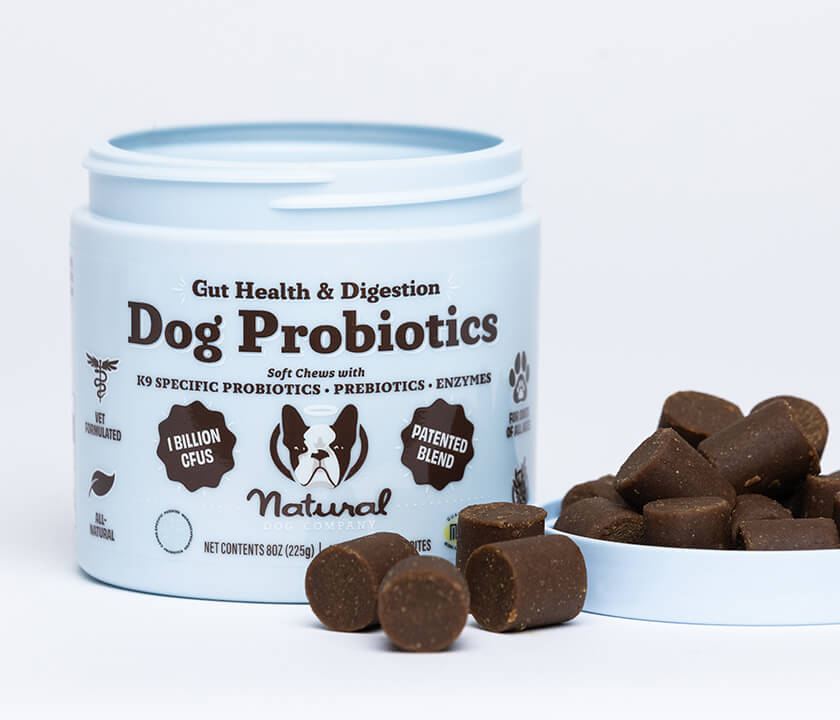Most bug bites on dogs are just an itchy nuisance, but in rare cases, they can be life-threatening. In this guide, we’ll cover how to identify and treat the most common types of bug bites. You’ll also learn to spot the clinical signs of a serious allergic reaction, and some all-natural treatments for bug bites and other irritations.
How to Identify Insect Bites on Dogs

Mosquitos tend to bite dogs on short-haired portions of the body such as the face and belly.
Mosquito Bites on Dogs
What to check for: firm, irregularly shaped bumps that occur in random, isolated spots. Since mosquito needles are so small (there are actually six of them), it’s usually impossible to see the point of penetration, even if the bite is on a hairless patch of skin like the belly.
Another telling clue is that mosquito bites become itchy much quicker than other bug bites. So if your pup starts scratching immediately after a quick trip outside, a whirring bloodsucker is likely to blame. (In contrast, dogs will often lick or chew bites that are more painful than itchy.)
Mosquitoes are usually nothing to worry about
Heartworm disease is a commonly cited concern for mosquito bites. But dogs on monthly heartworm preventatives are completely protected against the disease.
The only exception is if your dog was infected about a month before starting medication. After about 50 days, heartworms reach their adult stage and cannot be eliminated by preventative medication.
There’s one other scenario to watch out for: Like humans, some dogs are allergic to mosquito bites. Swelling and itchiness may be more severe. But your pup’s in no danger unless swelling in the face, nose, or throat interferes with breathing.

Flea-bite induced dermatitis on a dog with a flea allergy.
Flea Bites on Dogs
What to check for: clusters of small, red bumps usually found around the paws, belly, or folds of skin. There’s often a red halo around the bite center. The presence of small black pepper-like specs called flea dirt (or flea dust) provide a sure-fire diagnosis. You may notice more intense itching and chewing if your dog has a flea allergy.
Fleas are active year-round, but they’re most aggressive in warmer months. Check the AKC’s guide to see your state’s official flea and tick season.
Fleas spend very little of their life on your pet. A majority of the time they’re bounding around your yard or home. So if you find clusters of red bumps on your dog in the winter, and you aren’t getting bit yourself, it’s possible you’re dealing with a mite infestation instead.

Ticks attached to a dog’s face; these arachnids typically latch around the face, ears, and groin.
Tick Bites on Dogs
What to check for: It’s easy to identify tick bites if the bug is still attached. Otherwise, it can be pretty difficult to distinguish the mark of a tick from a mosquito: a small red bump.
Ticks can be active in any season or weather as long as the temperature is above freezing. Check the AKC’s guide to learn about your state’s official flea and tick season.

A tick removal hook is an affordable and indispensable tool to keep with your dog supplies!
How to get a tick off a dog
The key to safely removing a tick is using a tick removal hook or fine-point tweezers. Grasp the tick as close to your dog’s skin as possible and gently pull up until the tick releases.
Never use your fingers or blunt-tip household tweezers because you might end up squeezing more infectious material into the bite. You could also tear the mouth (which most people incorrectly believe is the tick’s head), leaving parts of it embedded in the skin.
Ticks and Lyme disease
Lyme disease is a common concern for dogs all over the US. It’s also a somewhat controversial topic in the world of veterinary medicine because the diagnosis can be tricky.
The bacteria responsible, Borrelia burgdorferi, is spread only through tick bites. Initially, a tick bite looks like your average mosquito bite. But if your pup is infected, a circular rash may appear anywhere from 3 to 30 days after the bite. The catch is that the rash only shows up for around 80% of infectees, leaving the other 20% with no visible signs of infection.
Even though traditional blood tests have been replaced by two much more effective methods (the Snap 4Dx and QC6), many dogs that test positive aren’t clinically ill and don’t need treatment. If a dog tests positive, the next step is to check whether the levels of a specific antibody (C6) are high enough to warrant treatment. Even then, some veterinarians may want to run additional blood and urine tests before making a decision.

Black widow spiders are abundant in the American south and commonly found in dark, secluded area like garages, basements, and cluttered areas.
Spider Bites on Dogs
Most spiders are relatively harmless for dogs. Mild swelling and tenderness are usually the worst symptoms you’ll see. However, there are two types of spiders that can inflict serious harm on curious pups: Loxosceles (recluses) and Latrodectus (widows).
Identifying venomous bites
Widow and Recluse bites are primarily diagnosed based on clinical signs that may take hours (or even days) to develop. Intense pain and lesions around the bite center are two of the most telling signs that your dog was poisoned. Seizures, muscle stiffness, lethargy, paralysis, vomiting, and fever are also big indicators. If your dog experiences any of these symptoms at any point, see your vet.
Venomous spider bites can manifest in two ways: local reactions and systemic reactions. This is important because in systemic reactions bite marks don’t always change in color or appearance. In other words, it’s possible your dog has been poisoned even if you don’t see a gnarly black lesion.

A sting in the face can cause serious swelling, but it’s generally not dangerous unless breathing is restricted.
Hornet, Wasp, and Bee Stings on Dogs
What to check for: Swelling is the biggest identifier for stings. Insects like bees and hornets are quick to retaliate when harassed or stepped on, so most stings occur on the face, head, or paws after you dog accidentally disturbs a nest or a hive, or tramples one of these insects.
How to get a bee stinger out of a dog’s skin
If your dog is stung by a bee, there’s a chance the stinger might still be embedded in the wound. Don’t use tweezers to remove the stinger because squeezing it will release more venom. Instead, scrape a credit card over your pup’s coat until it pops out, then flick the stinger away.
Ant Bites on Dogs
What to check for: small red bumps with a rounded raised center. Fire ant bites will often turn into pus-filled blisters that look a lot like pimples. Dogs often pick up ants after they step in a mound, so make sure to check for stragglers roaming around the fur.

Black fly bites show up immediately as dark red circles, usually on the dog’s underside.
Fly Bites on Dogs
What they look like: a flat, red splotch. Sometimes these bites will have an outline and other times the entire splotch will be a dark red. Black flies and Horseflies are the most aggressive types of flies and can even draw blood.
Small, annoying flies, like yellow flies and no-see-ums, leave a much smaller mark. Black flies and Horseflies are primarily found buzzing around large farm animals. So if you live near or on a farm, the likelihood that the bite you’re looking at came from a larger fly is much higher.
How Do I Know If It’s an Emergency?
There are four different types of allergic reactions that your dog might experience after an insect bite. The good news is that only two have the potential to be life-threatening, and the symptoms are easy to identify.
Types of allergic reactions seen in dogs:
- Anaphylactic: The most severe type of allergic reaction—fatal without treatment. Symptoms can reach a life-threatening stage in as little as 20 minutes.
- Edema: You’ll see significant swelling in the face or throat, but it’s easily treatable and only dangerous if the swelling interferes with your pup’s ability to breathe. Vets usually treat this with an antihistamine injection, but untreated, it will subside in a couple of days.
- Hives (Urticaria): Hives are incredibly annoying and itchy, but not life threatening.
- Allergic Dermatitis: Your dog will have itchy, flaky skin.
Clinical signs of a serious allergic reaction:
In extremely rare cases, insect bites can trigger anaphylaxis. Anaphylaxis is a rapidly occurring emergency that can affect major organs, restrict blood flow to the brain (sometimes causing seizures), and prevent your dog from breathing.
If you observe any combination of the following symptoms in your dog, see your veterinarian immediately:
- Hives or swelling in areas other than the bite
- Vomiting
- Diarrhea
- Dizziness or disorientation
- Seizures
- Wheezing
- Excessive drooling
With anaphylaxis, one of the most important things to look for (outside of a seizure, of course) is swelling in areas other than the bite. Anaphylaxis is a systemic reaction that erupts all over the body and in multiple organs.
How to tell if your dog can’t breathe:
Reactions that cause a face or throat edema are generally much less serious than anaphylaxis, but they can be fatal if they constrict the airway. Check for any of the symptoms below to determine whether your dog is having trouble breathing.
- Flaring nostrils when breathing
- Breathing with an open mouth
- Breathing with the elbows jutted out from the body
- The belly expands and moves much more than normal during each breath
- Noisy and scratchy breathing
Can I give my dog Benadryl?
Benadryl is a great medication for dogs with mild allergies, but it should never be self-prescribed. Always consult with your vet before trying an allergy medication out on your dog. Depending on your pooch’s health, Benadryl might actually make things worse.
Soothe Insect Bites and Stings with Skin Soother
No matter the variety of bite, there are two things you can almost always count on: redness and itching. If you’ve been a dog owner for any amount of time, you know how miserable these can make your pup. All that scratching and licking can even make the wound worse.
A Topical Balm for Immediate Relief
Skin Soother is an all-natural topical treatment that’s perfect to keep handy at home or while you’re on the go. It’s super easy to apply (no mixing, no hassle) and it’s packed with antibacterial herbs that reduce inflammation and relieve the affected areas.

Both of my pups managed to get into something outside that causes bug bite marks all over their underbellies. After one use of the Skin Soother, the next day the marks were almost gone! I am I lifetime customer and I’ve already ordered more. — Anna and her Lab mixes, Oakley and Aspen
Itchy Dog Shampoo for All-Over Soothing
Did your pup come home from a romp in the yard covered in bites? Getting over a flea problem? Dealing with allergies or food sensitivity? Stop the jingling-tags chorus of constant scratching with a luxurious bath with Itchy Dog Shampoo! Our proprietary formula is packed with powerhouse ingredients to soothe itching and calm swelling and redness. Combined with Skin Soother, your itchy pup will be feeling better in no time.
Bought the Itchy Dog Shampoo for my 10 month old Boston. He was so itchy, I took him to vet and spent a fortune on Cyto-Point injections and Benadryl shots but nothing seemed to work. Used Itchy Dog Shampoo once he is 60 percent better, next bath he is 90 percent better. He actually makes it through the night now without waking me up itching. This product is wonderful!!!! — JoLynn and her Boston Terrier












